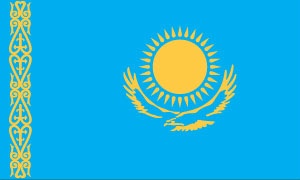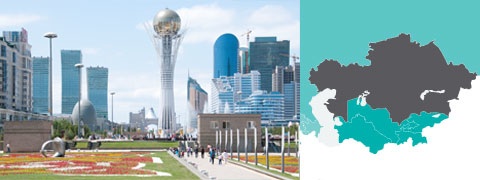Country assessments
Kazakhstan
- Details
- Country assessments
2013 sector transition indicators
Source: EBRD.
Note: Water – Water and wastewater; IAOFS – Insurance and other financial services; PE – Private equity.
Highlights
- GDP growth has been decelerating, but remains relatively strong. It slowed, from over 7 per cent in 2011 to 5 per cent in 2012 and 5.1 per cent in the first half of 2013, year-on-year, against the backdrop of weaker external demand.
- De-licensing reforms have advanced. The list of activities subject to licences and permits has been reduced by around by 30 per cent, and a larger number of permits can now be issued on a notification basis. The reform complements earlier measures designed to make it easier to start a business and resolve insolvency.
- The government launched the "People’s initial Public Offering (IPO)" programme. In a pilot placement, a 10 per cent stake in Kaztransoil – an oil pipeline company – was sold to individuals, pension funds and other investors.
Key priorities for 2014
- Diversification of the economy remains the overarching development challenge. Lowering dependence on hydrocarbon exports relies on improving the business environment, widening the skills base of the economy and implementing policies to support innovation, such as favourable tax treatment for research and development spending and secure property rights for intellectual property.
- The persistently high level of non-performing assets in the banking system needs to be addressed. Bad loans on the books of banks need to be properly assessed, and restructured, written off or sold on at a discount to specialised distressed asset funds.
- Competitive underpinnings of the local capital markets need to be preserved. Given that the centralised pension fund may become the single dominant player in the local capital market, special measures may need to be taken to ensure a level playing field. For example, outsourcing the management of parts of the fund to independent asset managers could be considered.
Macroeconomic performance
Economic growth decelerated somewhat. It slowed, from over 7 per cent in 2011 to 5 per cent in 2012 and 5.1 per cent in the first half of 2013. Nonetheless, growth remained relatively high, supported by high commodity prices and public expenditure growth. The deceleration in 2013 reflects more difficult global economic conditions, and weaker performance in the mining and construction sectors. The inflation rate fluctuated within the targeted range – around 6 per cent – reflecting, in part, volatile food prices. The exchange rate has remained broadly stable between the beginning of 2012 and mid-2013, and the current account has remained in surplus over the same period, owing to high commodity prices. The fiscal position remains strong overall, and the government could draw on substantial fiscal savings accumulated in the National Oil Fund in the event of a major correction in commodity prices.
Bank credit growth has resumed, and stood at around 13 per cent year-on-year in 2012-13. However, it varied across banks, and has been partly driven by various programmes of state-supported lending at below-market interest rates. The non-performing loans (NPLs) ratio remains high, at above 30 per cent, reflecting poor asset quality at BTA Bank, the country’s third largest bank – which has completed its second debt restructuring – as well as at other banks. High NPLs remain a drag on credit growth. Several large banks saw further downgrades of their credit ratings by leading rating agencies during the past year, including Kazkommertzbank – Kazakhstan’s largest bank – and Alliance Bank, which is majority-owned by the state. The downgrades reflected a weakening liquidity position, deteriorating asset quality and eroding profitability. Despite weaknesses in the banking system, in November 2012 Fitch joined S&P in upgrading Kazakhstan’s sovereign ratings to BBB+, on the strength of the country’s external balance sheet and healthy growth prospects.
Growth is expected to accelerate to above 5.5 per cent in 2013. This is notwithstanding the delays faced by Kashagan and other major oil projects. The outlook for growth in 2014 and beyond depends primarily on the evolution of commodity prices.
Major structural reform developments
The President has outlined the country’s long-term development strategy. The key objective of the strategy, which has a horizon of 2050, is to ensure that Kazakhstan becomes one of the top 30 most-developed countries in the world. To achieve this objective, a greater emphasis is to be placed on economic diversification, innovation, support to small and medium-sized enterprises, continuing privatisation and improving social standards.
An important anchor of the diversification and modernisation strategy is the green economy concept, formalised by a presidential decree in May 2013. The concept document spans the period 2013-50, and covers a broad range of sectors and issues, from improving energy efficiency standards of residential buildings and infrastructure assets to better management of water resources.
A new holding company has taken over responsibilities for overseeing state development institutions. Baiterek Holding, created in May 2013, took over the management of a number of state development and financial institutions from the National Welfare Fund Samruk-Kazyna and the National Bank of Kazakhstan. These include the Development Bank of Kazakhstan, the Kazakh Mortgage Company, the National Agency for Technological Development, the Distressed Assets Fund, Kazyna Capital Management, the Investment Fund of Kazakhstan, and the Damu Entrepreneurship Development Fund. Following this reform, Samruk-Kazyna will focus on managing its portfolio of real sector assets. The restructuring aims at improving the efficiency of key state development institutions.
The announced large-scale privatisation programme started with a pilot deal. The “People’s IPO” is an initiative to sell shares (minority stakes) in selected major companies to citizens, pension funds and, on a residual basis, other interested investors. The first IPO under the programme was successfully completed in December 2012, whereby the government placed a 10 per cent stake in KazTransOil – an oil pipeline company. The placement attracted strong demand from pension funds, individuals and other investors, with over 26,000 bids, totalling US$ 372 million, which represented double the equity on offer. Approximately US$ 130 million of the demand came from citizens – the target audience of the IPO – many of them pensioners. A minority stake in the national grid company is likely to be offered next. Another wave of privatisation is envisaged beyond 2015, whereby national holdings may be offered to strategic global investors.
De-licensing reforms have advanced. A new law, which came into effect in January 2013, reduced the list of activities subject to licences and permits by 30 per cent, abolishing a total of 257 permits. Forty more permits can now be issued on a notification basis. The package complements earlier measures designed to make it easier to start a business and resolve insolvency. These reforms helped Kazakhstan to ascend to fiftieth position in the World Bank 2014 Doing Business report. Furthermore, investors can now approach the investment ombudsman in the case of problems and disputes. The first meeting of the investment ombudsman took place in June 2013, and its work will be steered by a working group led by the deputy prime minister and comprising officials from various ministries and agencies.
The law on public-private partnerships (PPP) was amended in July 2013. The amendments extend potential application of PPPs to certain areas of municipal infrastructure, health, education, and information technologies, and broaden the range of permissible contract structures.
Resolution of non-performing loans has been slow. This is despite earlier measures introduced in 2011-12 to temporarily remove some of the tax disincentives for NPL write-offs, and to create the second Distressed Assets Fund. In March 2013 UniCredit Bank of Italy sold its Kazakhstani subsidiary, ATF Bank, to the local KazNitrogenGaz (KNG) group for a fraction of the price it had paid in 2007, largely reflecting ATF Bank’s high ratio of non-performing assets.
Individual pension accounts are being centralised into a single pension fund under the management of the National Bank of Kazakhstan. Following an announcement in January 2013, the country’s 11 pension funds will be merged into a single fund under central bank management. The reform aims to achieve savings on management fees and to eliminate opportunities for related party transactions. The new pension bill also introduces other changes to the pension system, including a gradual, staged increase in the retirement age for women, commencing from 2018. In parallel, the National Bank increased its stake in the Kazakhstan Stock Exchange to a majority, controlling stake, through the purchase of new shares.
Further major steps in terms of regional economic integration within the framework of the Eurasian Economic Union are expected in 2015. At a summit in Astana, in May 2013, the heads of member states of the Eurasian Economic Union – Belarus, Kazakhstan and Russia – agreed to prepare draft documents on further integration by May 2014, and to adopt them in May 2015. In addition, a new railway line, inaugurated in May 2013, connected Kazakhstan with northern Turkmenistan, with an onward connection to Iran currently under construction. The link will improve transport connectivity in Central Asia.
World Trade Organization accession talks continue. A number of issues remain to be resolved, including in the areas of support for agriculture and local content requirements in the energy sector.













